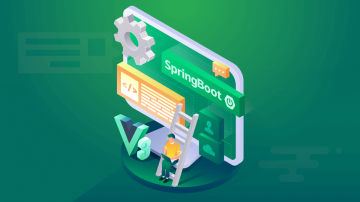本文详细介绍了Spring Boot项目开发的全过程,涵盖环境搭建、快速入门、实战案例和常见问题解决等内容,帮助读者从入门到实践掌握Spring Boot项目开发教程。
SpringBoot项目开发教程:从入门到实践1. SpringBoot简介
什么是SpringBoot
Spring Boot 是由Pivotal团队提供的全新框架,旨在简化Spring应用的初始搭建以及开发过程。它通过约定优于配置的原则,大幅度减少了配置代码,使开发者可以快速构建独立的、生产级别的基于Spring的应用程序。Spring Boot的核心是自动配置,通过一系列默认的配置和最佳实践来减少开发者的工作量。
SpringBoot的优势
Spring Boot 通过一系列强大而灵活的特性帮助开发者快速搭建应用。以下是一些主要优势:
- 自动配置:Spring Boot 可以根据应用所声明的依赖自动配置所需的bean。
- 独立运行:支持嵌入式服务,可以打包为可执行的jar(内含所有依赖)。
- 无需XML配置:以约定优于配置的方式,减少繁琐的XML配置。
- 支持云部署:简化应用部署到云服务器的过程。
- 热部署:支持代码热部署,加快开发速度。
- 强大的Starter依赖:提供一系列预配置的依赖集,简化依赖管理。
SpringBoot生态介绍
Spring Boot 生态系统包含了很多独立的项目,每个项目都有其特定的用途和功能。以下是Spring Boot生态系统中的一些重要部分:
- Spring Data:提供了一组抽象,用于从各种数据存储中访问数据。
- Spring Security:用于保护应用不受安全威胁。
- Spring Batch:用于处理批量数据处理任务。
- Spring WebFlux:支持响应式编程,适用于异步和事件驱动的场景。
- Spring Cloud:帮助开发者快速搭建分布式系统,包含服务发现、配置管理等模块。
2. 环境搭建
开发环境要求
- Java: 最好使用Java 11及以上版本,因为Spring Boot 2.3+ 版本推荐使用Java 11。
- IDE: 推荐使用 IntelliJ IDEA 或 Eclipse。
- Maven/Gradle: 用于构建项目。
- Git: 版本控制系统,用于代码管理。
开发工具安装
-
Java安装:
# 下载Java JDK wget https://download.java.net/java/GA/jdk11.0.1/077f9b1c452643f29b210ac1280cfd9f/24b84a7686f14ad98433e79ce7ebc512/jdk-11.0.1_linux-x64_bin.tar.gz # 解压 tar -xvf jdk-11.0.1_linux-x64_bin.tar.gz sudo mv jdk-11.0.1 /usr/local/java/jdk11 # 环境变量配置 export JAVA_HOME=/usr/local/java/jdk11 export PATH=$JAVA_HOME/bin:$PATH - IDE安装:
- IntelliJ IDEA:
- 访问官网下载最新版IntelliJ IDEA。
- 安装完成后,启动IDE。
- 选择
File->New->Project,选择Spring Initializr。
- Eclipse:
- 访问官网下载最新版Eclipse。
- 安装完成后,启动Eclipse。
- 通过
Help->Eclipse Marketplace搜索Spring Tools Suite插件并安装。
- IntelliJ IDEA:
创建第一个SpringBoot项目
使用Spring Initializr快速创建一个Spring Boot项目。
- 访问 http://start.spring.io/,选择构建工具为Maven或Gradle,选择Spring Boot版本,项目名,以及添加依赖(例如Spring Web)。
- 点击
Generate下载项目压缩包。 - 解压压缩包,打开项目,导入IDE中。
- 项目结构如下:
src/main/java: 存放Java源代码。src/main/resources: 存放配置文件,如application.properties。src/test/java: 存放测试代码。
创建启动类和Controller类
- 启动类(DemoApplication.java)
package com.example.demo;
import org.springframework.boot.SpringApplication;
import org.springframework.boot.autoconfigure.SpringBootApplication;
@SpringBootApplication
public class DemoApplication {
public static void main(String[] args) {
SpringApplication.run(DemoApplication.class, args);
}
}
- **Controller类(HelloController.java)**
```java
package com.example.demo;
import org.springframework.web.bind.annotation.GetMapping;
import org.springframework.web.bind.annotation.RestController;
@RestController
public class HelloController {
@GetMapping("/hello")
public String hello() {
return "Hello World!";
}
}3. 快速入门
实现第一个RESTful API
创建一个简单的RESTful API,用于返回"Hello World"。
- 创建一个新的Spring Boot项目。
- 在
src/main/java目录下创建一个Controller类。 - 添加如下代码:
package com.example.demo;
import org.springframework.web.bind.annotation.GetMapping;
import org.springframework.web.bind.annotation.RestController;
@RestController
public class HelloController {
@GetMapping("/hello")
public String hello() {
return "Hello World!";
}
}- 启动项目,访问
http://localhost:8080/hello,将看到返回的"Hello World!"。
使用SpringBoot Starter快速搭建项目
Spring Boot Starter提供了一站式的依赖管理,简化了项目的配置。
- 在
pom.xml或build.gradle中添加Spring Boot Starter依赖:
<dependencies>
<dependency>
<groupId>org.springframework.boot</groupId>
<artifactId>spring-boot-starter-web</artifactId>
</dependency>
</dependencies>- 启动类使用
@SpringBootApplication注解,简化配置:
package com.example.demo;
import org.springframework.boot.SpringApplication;
import org.springframework.boot.autoconfigure.SpringBootApplication;
@SpringBootApplication
public class DemoApplication {
public static void main(String[] args) {
SpringApplication.run(DemoApplication.class, args);
}
}配置文件详解
Spring Boot 使用application.properties或application.yml文件来存储配置信息。
application.properties示例:
# 端口号
server.port=8080
# 数据库配置
spring.datasource.url=jdbc:mysql://localhost:3306/demo
spring.datasource.username=root
spring.datasource.password=root
spring.datasource.driver-class-name=com.mysql.cj.jdbc.Driverapplication.yml示例:
server:
port: 8080
spring:
datasource:
url: jdbc:mysql://localhost:3306/demo
username: root
password: root
driver-class-name: com.mysql.cj.jdbc.Driver4. 实战案例
数据库集成与操作
集成MySQL数据库,并进行CRUD操作。
- 添加依赖:
<dependency>
<groupId>org.springframework.boot</groupId>
<artifactId>spring-boot-starter-data-jpa</artifactId>
</dependency>
<dependency>
<groupId>mysql</groupId>
<artifactId>mysql-connector-java</artifactId>
</dependency>- 配置数据库连接:
# application.properties
spring.datasource.url=jdbc:mysql://localhost:3306/demo
spring.datasource.username=root
spring.datasource.password=root
spring.jpa.hibernate.ddl-auto=update
spring.jpa.show-sql=true- 创建实体类:
package com.example.demo.entity;
import javax.persistence.Column;
import javax.persistence.Entity;
import javax.persistence.GeneratedValue;
import javax.persistence.GenerationType;
import javax.persistence.Id;
@Entity
public class User {
@Id
@GeneratedValue(strategy = GenerationType.IDENTITY)
private Long id;
@Column(nullable = false, unique = true)
private String username;
@Column(nullable = false)
private String password;
// getters and setters
}- 创建Repository接口:
package com.example.demo.repository;
import com.example.demo.entity.User;
import org.springframework.data.jpa.repository.JpaRepository;
public interface UserRepository extends JpaRepository<User, Long> {
}- 创建Service类:
package com.example.demo.service;
import com.example.demo.entity.User;
import com.example.demo.repository.UserRepository;
import org.springframework.beans.factory.annotation.Autowired;
import org.springframework.stereotype.Service;
import java.util.List;
@Service
public class UserService {
@Autowired
private UserRepository userRepository;
public User saveUser(User user) {
return userRepository.save(user);
}
public User getUserById(Long id) {
return userRepository.findById(id).orElse(null);
}
public List<User> getAllUsers() {
return userRepository.findAll();
}
public void deleteUser(Long id) {
userRepository.deleteById(id);
}
}- 创建Controller类:
package com.example.demo.controller;
import com.example.demo.entity.User;
import com.example.demo.service.UserService;
import org.springframework.beans.factory.annotation.Autowired;
import org.springframework.web.bind.annotation.*;
import java.util.List;
@RestController
@RequestMapping("/users")
public class UserController {
@Autowired
private UserService userService;
@GetMapping
public List<User> getAllUsers() {
return userService.getAllUsers();
}
@PostMapping
public User createUser(@RequestBody User user) {
return userService.saveUser(user);
}
@GetMapping("/{id}")
public User getUser(@PathVariable Long id) {
return userService.getUserById(id);
}
@DeleteMapping("/{id}")
public void deleteUser(@PathVariable Long id) {
userService.deleteUser(id);
}
}静态资源管理
Spring Boot 提供了内置的静态资源处理,自动将src/main/resources/static或src/main/resources/public目录下的文件作为静态资源文件。
- 创建静态资源文件:
- 在
src/main/resources/static目录下创建一个index.html:
- 在
<!DOCTYPE html>
<html>
<head>
<title>Spring Boot Static Resource Demo</title>
</head>
<body>
<h1>Welcome to Spring Boot Static Resource Demo</h1>
</body>
</html>- 访问
http://localhost:8080/,页面会显示index.html内容。
日志配置与使用
Spring Boot 使用Logback作为默认的日志实现。
- 配置日志级别:
# application.properties
logging.level.root=INFO
logging.level.org.springframework.web=DEBUG- 在代码中使用日志:
package com.example.demo.service;
import org.slf4j.Logger;
import org.slf4j.LoggerFactory;
public class UserService {
private static final Logger logger = LoggerFactory.getLogger(UserService.class);
public void logInfo() {
logger.info("Logging info message");
}
}5. 常见问题与解决方案
常见错误排查
- 启动失败:检查依赖版本是否冲突,检查配置文件中的配置是否正确。
- 找不到数据库连接:检查数据库服务是否启动,数据库连接字符串是否正确。
示例:检查application.properties文件中的数据库配置:
spring.datasource.url=jdbc:mysql://localhost:3306/demo
spring.datasource.username=root
spring.datasource.password=root
spring.datasource.driver-class-name=com.mysql.cj.jdbc.Driver性能优化技巧
- 启用缓存:使用
Spring Cache注解来缓存频繁访问的数据。 - 数据库优化:确保数据库表的设计合理,索引设置正确。
示例:启用Spring Cache:
package com.example.demo.service;
import org.springframework.cache.annotation.Cacheable;
import org.springframework.stereotype.Service;
@Service
public class UserService {
@Cacheable(value = "users", key = "#id")
public User getUserById(Long id) {
// 从数据库获取用户
return userRepository.findById(id).orElse(null);
}
}- 配置缓存类型:
spring.cache.type=simple依赖冲突解决
- 查看依赖树:使用
mvn dependency:tree查看依赖树,找出冲突项。 - 排除冲突依赖:在
pom.xml中排除冲突的依赖。
示例:排除冲突依赖:
<dependency>
<groupId>com.example</groupId>
<artifactId>conflict-dependency</artifactId>
<version>1.0.0</version>
<exclusions>
<exclusion>
<groupId>org.example</groupId>
<artifactId>conflict-artifact</artifactId>
</exclusion>
</exclusions>
</dependency>6. 项目部署与运维
打包发布
- 使用Maven打包:
mvn clean package- 打包后的可执行jar文件位于
target目录下。
部署到Tomcat
- 将打包好的jar文件放置到Tomcat的
webapps目录下。 - 启动Tomcat。
示例:
# 将jar文件复制到Tomcat webapps目录
cp target/*.jar /path/to/tomcat/webapps/
# 启动Tomcat
cd /path/to/tomcat
./bin/startup.sh日常运维注意事项
- 日志监控:定期查看日志文件,确保应用运行正常。
- 性能监控:使用工具(如Prometheus、Grafana)监控应用性能。
- 备份与恢复:定期备份数据库,确保数据安全。
总结,通过以上各个部分的学习与实践,你将能够熟练使用Spring Boot进行项目开发,从环境搭建到解决常见问题,再到项目部署与运维,你将能够应对各种开发需求,快速构建出高质量的应用程序。

 随时随地看视频
随时随地看视频




